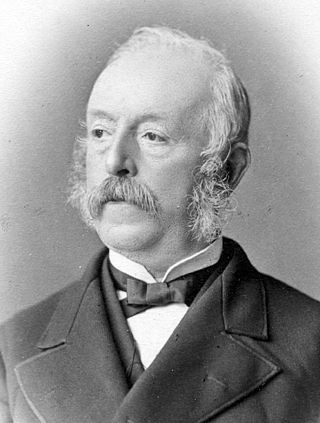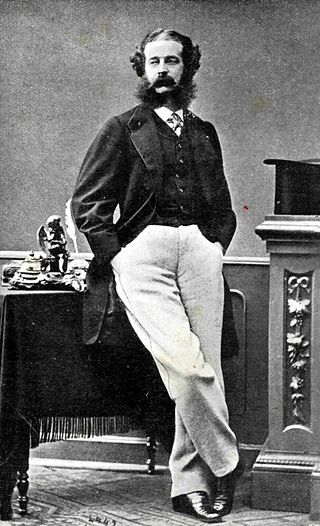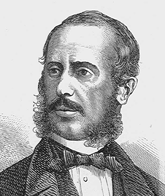
Marco Minghetti was an Italian economist and statesman.

Agostino Depretis was an Italian statesman and politician. He served as Prime Minister of Italy for several stretches between 1876 and 1887, and was leader of the Historical Left parliamentary group for more than a decade. He is the fourth-longest serving Prime Minister in Italian history, after Benito Mussolini, Giovanni Giolitti and Silvio Berlusconi, and at the time of his death he was the longest-served. Depretis is widely considered one of the most powerful and important politicians in Italian history.

Emilio, marquis Visconti-Venosta was an Italian statesman. He is one of the longest-serving Ministers of Foreign Affairs in the history of Italy.

Palazzo Braschi is a large Neoclassical palace in Rome, Italy and is located between the Piazza Navona, the Campo de' Fiori, the Corso Vittorio Emanuele II and the Piazza di Pasquino. It presently houses the Museo di Roma, the "Museum of Rome", covering the history of the city in the period from the Middle Ages through the nineteenth century.
The Historical Far Left, originally known as Far Left, Radical Extreme, simply The Extreme, or Party of Democracy, was a left-wing parliamentary group and coalition of Radical, Republican and Socialist politicians in Italy during the second half of the 19th century. Formerly known as the extreme wing of the Historical Left before the unification of Italy, it became a separate group when the more moderate branch of the Left accepted the leadership of the House of Savoy to build the new Italian state.

Lady from Lisbon is a 1942 British comedy film directed by Leslie S. Hiscott and starring Francis L. Sullivan, Jane Carr, Martita Hunt and Charles Victor.

General elections were held in Italy on 8 November, with a second round of voting on 15 November. They were a snap election, called by Prime Minister Marco Minghetti to strengthen his majority.

General elections were held in Italy on 5 November, with a second round of voting on 12 November.

General elections were held in Italy on 16 May 1880, with a second round of voting on 23 May.
General elections were held in Italy on 29 October 1882, with a second round of voting on 5 November. The "ministerial" left-wing bloc emerged as the largest in Parliament, winning 289 of the 508 seats.
The Right group, later called Historical Right by historians to distinguish it from the right-wing groups of the 20th century, was an Italian conservative parliamentary group during the second half of the 19th century. After 1876, the Historical Right constituted the Constitutional opposition toward the left governments. It originated in the convergence of the most liberal faction of the moderate right and the moderate wing of the democratic left. The party included men from heterogeneous cultural, class, and ideological backgrounds, ranging from British-American individualist liberalism to Neo-Hegelian liberalism as well as liberal-conservatives, from strict secularists to more religiously-oriented reformists. Few prime ministers after 1852 were party men; instead they accepted support where they could find it, and even the governments of the Historical Right during the 1860s included leftists in some capacity.
Angelo Minghetti (1822–1885) was an Italian ceramist and painter of maiolica pieces.

Giuseppe Ugolino was an Italian sculptor and painter.

Ergostine is an ergoloid-like chemical made by Claviceps purpurea.

Prospero Minghetti was an Italian painter.
The Liberal Constitutional Party was a political party in Italy, born to represent the liberal-conservative and anti-Transformist wing of the Historical Right. Their members were usually labeled as Constitutionals or Liberal-Conservatives, especially during the leadership of Rudinì and Sonnino.
The Liberal Union, simply and collectively called Liberals, was a political alliance formed in the first years of the 20th century by the Italian Prime Minister and leader of the Historical Left Giovanni Giolitti. The alliance was formed when the Left and the Right merged in a single centrist and liberal coalition which largely dominated the Italian Parliament.

Giuseppe Pasolini was an Italian politician.

The Minghetti II government of Italy held office from 10 July 1873 until 25 March 1876, a total of 989 days, or 2 year, 8 months and 15 days.













